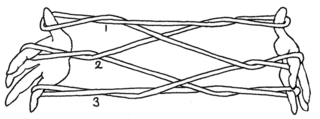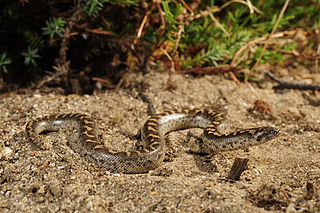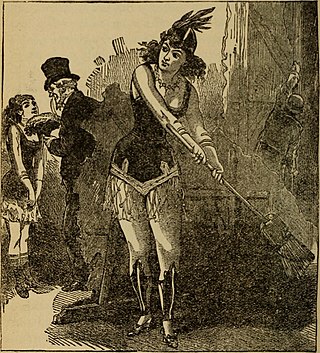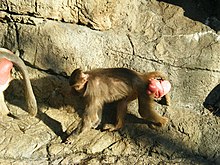
The menstrual cycle is a series of natural changes in hormone production and the structures of the uterus and ovaries of the female reproductive system that makes pregnancy possible. The ovarian cycle controls the production and release of eggs and the cyclic release of estrogen and progesterone. The uterine cycle governs the preparation and maintenance of the lining of the uterus (womb) to receive an embryo. These cycles are concurrent and coordinated, normally last between 21 and 35 days, with a median length of 28 days, and continue for about 30–45 years.

Ovulation is the release of eggs from the ovaries. In women, this event occurs when the ovarian follicles rupture and release the secondary oocyte ovarian cells. After ovulation, during the luteal phase, the egg will be available to be fertilized by sperm. In addition, the uterine lining (endometrium) is thickened to be able to receive a fertilized egg. If no conception occurs, the uterine lining as well as the egg will be shed during menstruation.

Sexual attraction is attraction on the basis of sexual desire or the quality of arousing such interest. Sexual attractiveness or sex appeal is an individual's ability to attract other people sexually, and is a factor in sexual selection or mate choice. The attraction can be to the physical or other qualities or traits of a person, or to such qualities in the context where they appear. The attraction may be to a person's aesthetics, movements, voice, or smell, among other things. The attraction may be enhanced by a person's adornments, clothing, perfume or hair style. It can be influenced by individual genetic, psychological, or cultural factors, or to other, more amorphous qualities. Sexual attraction is also a response to another person that depends on a combination of the person possessing the traits and on the criteria of the person who is attracted.

Sociobiological theories of rape explore how evolutionary adaptation influences the psychology of rapists. Such theories are highly controversial, as traditional theories typically do not consider rape a behavioral adaptation. Some object to such theories on ethical, religious, political, or scientific grounds. Others argue correct knowledge of rape causes is necessary for effective preventive measures.

Menstrual synchrony, also called the McClintock effect, or the Wellesley effect, is a contested process whereby women who begin living together in close proximity would experience their menstrual cycle onsets becoming more synchronized together in time than when previously living apart. "For example, the distribution of onsets of seven female lifeguards was scattered at the beginning of the summer, but after 3 months spent together, the onset of all seven cycles fell within a 4-day period."

Parental investment, in evolutionary biology and evolutionary psychology, is any parental expenditure that benefits offspring. Parental investment may be performed by both males and females, females alone or males alone. Care can be provided at any stage of the offspring's life, from pre-natal to post-natal.
The estrous cycle is a set of recurring physiological changes induced by reproductive hormones in females of mammalian subclass Theria. Estrous cycles start after sexual maturity in females and are interrupted by anestrous phases, otherwise known as "rest" phases, or by pregnancies. Typically, estrous cycles repeat until death. These cycles are widely variable in duration and frequency depending on the species. Some animals may display bloody vaginal discharge, often mistaken for menstruation. Many mammals used in commercial agriculture, such as cattle and sheep, may have their estrous cycles artificially controlled with hormonal medications for optimum productivity. The male equivalent, seen primarily in ruminants, is called rut.

A psychological adaptation is a functional, cognitive or behavioral trait that benefits an organism in its environment. Psychological adaptations fall under the scope of evolved psychological mechanisms (EPMs), however, EPMs refer to a less restricted set. Psychological adaptations include only the functional traits that increase the fitness of an organism, while EPMs refer to any psychological mechanism that developed through the processes of evolution. These additional EPMs are the by-product traits of a species’ evolutionary development, as well as the vestigial traits that no longer benefit the species’ fitness. It can be difficult to tell whether a trait is vestigial or not, so some literature is more lenient and refers to vestigial traits as adaptations, even though they may no longer have adaptive functionality. For example, xenophobic attitudes and behaviors, some have claimed, appear to have certain EPM influences relating to disease aversion, however, in many environments these behaviors will have a detrimental effect on a person's fitness. The principles of psychological adaptation rely on Darwin's theory of evolution and are important to the fields of evolutionary psychology, biology, and cognitive science.
Martha Kent McClintock is an American psychologist best known for her research on human pheromones and her theory of menstrual synchrony.

Sexual selection in humans concerns the concept of sexual selection, introduced by Charles Darwin as an element of his theory of natural selection, as it affects humans. Sexual selection is a biological way one sex chooses a mate for the best reproductive success. Most compete with others of the same sex for the best mate to contribute their genome for future generations. This has shaped human evolution for many years, but reasons why humans choose their mates are not fully understood. Sexual selection is quite different in non-human animals than humans as they feel more of the evolutionary pressures to reproduce and can easily reject a mate. The role of sexual selection in human evolution has not been firmly established although neoteny has been cited as being caused by human sexual selection. It has been suggested that sexual selection played a part in the evolution of the anatomically modern human brain, i.e. the structures responsible for social intelligence underwent positive selection as a sexual ornamentation to be used in courtship rather than for survival itself, and that it has developed in ways outlined by Ronald Fisher in the Fisherian runaway model. Fisher also stated that the development of sexual selection was "more favourable" in humans.
Odour is sensory stimulation of the olfactory membrane of the nose by a group of molecules. Certain body odours are connected to human sexual attraction. Humans can make use of body odour subconsciously to identify whether a potential mate will pass on favourable traits to their offspring. Body odour may provide significant cues about the genetic quality, health and reproductive success of a potential mate.
Menstruation is the shedding of the uterine lining (endometrium). It occurs on a regular basis in uninseminated sexually reproductive-age females of certain mammal species.
The challenge hypothesis outlines the dynamic relationship between testosterone and aggression in mating contexts. It proposes that testosterone promotes aggression when it would be beneficial for reproduction, such as mate guarding, or strategies designed to prevent the encroachment of intrasexual rivals. The positive correlation between reproductive aggression and testosterone levels is seen to be strongest during times of social instability. The challenge hypothesis predicts that seasonal patterns in testosterone levels are a function of mating system, paternal care, and male-male aggression in seasonal breeders.

Sexual swelling, sexual skin, or anogenital tumescence refers to localized engorgement of the anus and vulva region of some female primates that vary in size over the course of the menstrual cycle. Thought to be an honest signal of fertility, male primates are attracted to these swellings; preferring, and competing for, females with the largest swellings.
Promiscuity tends to be frowned upon by many societies that expect most members to have committed, long-term relationships. Among women, as well as men, inclination for sex outside committed relationships is correlated with a high libido, but evolutionary biology as well as social and cultural factors have also been observed to influence sexual behavior and opinion.
Cryptic female choice is a form of mate choice which occurs both in pre and post copulatory circumstances when females in certain species use physical or chemical mechanisms to control a male's success of fertilizing their ova or ovum; i.e. by selecting whether sperm are successful in fertilizing their eggs or not. It occurs in internally-fertilizing species and involves differential use of sperm by females when sperm are available in the reproductive tract.

Extended female sexuality is where the female of a species mates despite being infertile. In most species, the female only engages in copulation when she is fertile. However, extended sexuality has been documented in Old World primates, pair bonded birds and some insects. Extended sexuality is most prominent in human females who exhibit no change in copulation rate across the ovarian cycle.

Human mate guarding refers to behaviours employed by both males and females with the aim of maintaining reproductive opportunities and sexual access to a mate. It involves discouraging the current mate from abandoning the relationship whilst also warding off intrasexual rivals. It has been observed in many non-human animals, as well as humans. Sexual jealousy is a prime example of mate guarding behaviour. Both males and females use different strategies to retain a mate and there is evidence that suggests resistance to mate guarding also exists.
The ovulatory shift hypothesis holds that women experience evolutionarily adaptive changes in subconscious thoughts and behaviors related to mating during different parts of the ovulatory cycle. It suggests that what women want, in terms of men, changes throughout the menstrual cycle. Two meta-analyses published in 2014 reached opposing conclusions on whether the existing evidence was robust enough to support the prediction that women's mate preferences change across the cycle. A newer 2018 review does not show women changing the type of men they desire at different times in their fertility cycle.
Human reproductive ecology is a subfield in evolutionary biology that is concerned with human reproductive processes and responses to ecological variables. It is based in the natural and social sciences, and is based on theory and models deriving from human and animal biology, evolutionary theory, and ecology. It is associated with fields such as evolutionary anthropology and seeks to explain human reproductive variation and adaptations. The theoretical orientation of reproductive ecology applies the theory of natural selection to reproductive behaviors, and has also been referred to as the evolutionary ecology of human reproduction.











